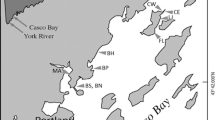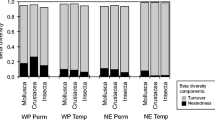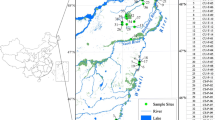Abstract
We evaluated the use of macroinvertebrates as a potential tool to identify dry and intensively farmed temporary and seasonal wetlands in the Prairie Pothole Region. The techniques we designed and evaluated used the dried remains of invertebrates or their egg banks in soils as indicators of wetlands. For both the dried remains of invertebrates and their egg banks, we weighted each taxon according to its affinity for wetlands or uplands. Our study clearly demonstrated that shells, exoskeletons, head capsules, eggs, and other remains of macroinvertebrates can be used, to identify wetlands, even when they are dry, intensively farmed, and difficult to identify as wetlands using standard criteria (i.e., hydrology, hydrophytic vegetation, and hydric soils). Although both dried remains and egg banks identified wetlands, the combination was more useful, especially for identifying drained or filled wetlands. We also evaluated the use of coarse taxonomic groupings to stimulate use of the technique by nonspecialists and obtained satisfactory results in most situations.
Similar content being viewed by others
Literature cited
Barnes, R. D. 1968. Invertebrate Zoology, 2nd Edition. W. B. Saunders Company, Philadelphia, PA, USA.
Borror, D. J., D. M. De Long, and C. A. Triplehorn 1981. An Introduction to the Study of Insects, 5th Edition. Saunders College Publishing, New York, NY, USA.
Clarke, A. H. 1981. The Freshwater Molluscs of Canada. National Museum of Natural Sciences, Ottawa, ON, Canada.
Cowardin, L. M., V. Carter, F. C. Golet, and E. T. LaRoe. 1979. Classification of wetlands and deepwater habitats of the United States. U.S. Fish and Wildlife Service, Washington, DC, USA. FWS/OBS-79/31.
Cowardin, L. M., D. H. Johnson, T. L. Shaffer, and D. W. Sparling. 1988. Applications of a simulation model to decisions in mallard management. U.S. Fish and Wildlife Service Technical Report 17.
Driver, E. A. 1977. Chironomid communities in small prairie ponds: some characteristics and controls. Freshwater Biology 7:121–133.
Eisenlohr, W.S., Jr. 1972. Hydrologic in vestigations of prairie potholes in North Dakota, 1959–1968. U.S. Geological Survey Professional Paper 585-A.
Elliott, J. M. 1977. Some methods for the statistical analysis of samples of benthic invertebrates. Freshwater Biological Association Scientific Publication Number 25.
Euliss, N. H., Jr. and D. M. Mushet. 1999. Influence of agriculture on aquatic in vertebrate communities of temporary wetlands in the prairie pothole region of North Dakota, USA. Wetlands 19:578–583.
Euliss, N. H., Jr., D. A. Wrubleski, and D. M. Mushet. 1999. Wetlands of the prairie pothole region: invertebrate species composition, ecology, and management. p. 471–514. In D. P. Batzer, R. B. Rader and S. A. Wissinger (eds.) Invertebrates in Freshwater Wetlands of North America—Ecology and Management. John Wiley & Sons, Inc., New York, NY, USA.
Federal Interagency Committee for Wetlands Delineation. 1989. Federal manual for identifying and delineating jurisdictional wetlands. U.S. Army Corps of Engineers, U.S. Environmental Protection Agency, U.S. Fish and Wildlife Service, and U.S.D.A. Soil Conservation Service, Washington, DC, USA. Cooperative Technical Publication.
Milliken, G. A. and D. E. Johnson. 1984. Analysis of messy data, volume 1: designed experiments. Van Nostrand Reinhold Company, New York, NY, USA.
National Research Council. 1995. Wetlands—characteristics and boundaries. National Academy Press, Washington, DC, USA.
Pennak, R. W. 1989. Fresh-water Invertebrates of the United States: Protozoa to Mollusca. 3rd Edition. John Wiley & Sons, Inc., New York, NY, USA.
Reed, P. B. 1988. National list of plant species that occur in wetlands: National summary. U.S. Fish and Wildlife Service Biological Report 88(24).
SAS Institute, Inc. 1997. SAS/STAT software: changes and enhancements through release 6.12. SAS Institute Inc., Cary, NC. USA.
Schneider, D. W. and T. M. Frost. 1996. Habitat duration and community structure in temporary ponds. Journal of the North American Benthological Society 15:64–86.
Stewart, R. E. and H. A. Kantrud. 1971. Classification of natural ponds and lakes in the glaciated prairie region. U.S. Fish and Wildlife Service Resource Publication 92.
Swanson, K. D. 1990. Chemical evolution of ground water in clay till in a prairie wetland setting in the Cottonwood Lake area, Stutsman county, North Dakota. M.S. Thesis. University of Wisconsin, Madison, WI, USA.
U.S. Army Corps of Engineers. 1987. USACE wetlands delineation manual. Environmental Laboratory, U.S. Army Corps of Engineers, Waterways Experiment Station. Vicksburg, MS, USA. Technical Report Y-87-1.
U.S. Department of Agriculture. 1994. National Food Security Act Manual, 3rd Edition. U.S. Department of Agriculture. Soil Conservation Service, Washington, DC, USA. Part 519, 180-V-NFSAM.
U. S. Department of Agriculture, Natural Resources Conservation Service. 1996. Field Indicators of Hydric Soils in the United States. G. W. Hurt, P. M. Whited, and R. F. Pringle (eds.), U.S. Department of Agriculture, Natural Resources Conservation Service, Fort Worth, TX, USA.
Wiggins, G. B. R. M. Mackay, and I. M. Smith. 1980. Evolutionary strategies of animals in annual temporary pools. Archiv für Hydrobiologie/Supplement 58:97–206.
Wilen, B. O. and M. K. Bates. 1995. The U.S. Fish and Wildlife Service’s National Wetlands Inventory project. Vegetatio 118: 153–169.
Winter, T. C. and D. O. Rosenberry. 1998. Hydrology of prairie wetlands during drought and deluge: a 17-year study of the Cottonwood Lake wetland complex in North Dakota in perspective of longer term measured and proxy hydrology records. Climate Change 40:189–209.
Author information
Authors and Affiliations
Rights and permissions
About this article
Cite this article
Euliss, N.H., Mushet, D.M. & Johnson, D.H. Use of macroinvertebrates to identify cultivated wetlands in the Prairie Pothole Region. Wetlands 21, 223–231 (2001). https://doi.org/10.1672/0277-5212(2001)021[0223:UOMTIC]2.0.CO;2
Received:
Revised:
Accepted:
Issue Date:
DOI: https://doi.org/10.1672/0277-5212(2001)021[0223:UOMTIC]2.0.CO;2




